Tivoli, Lazio
Tivoli (/ˈtɪvəli/, Italian: [ˈtiːvoli]; Latin: Tibur) is a town and comune in Lazio, central Italy, about 30 kilometres (19 miles) east-north-east of Rome, at the falls of the Aniene river where it issues from the Sabine hills. The city offers a wide view over the Roman Campagna.
Tivoli | |
|---|---|
| Comune di Tivoli | |
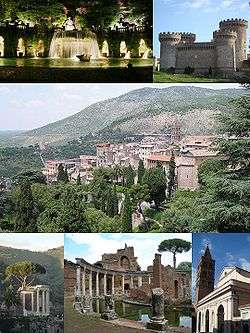 Main attractions of Tivoli, Top left: View of big fountain in Villa d'Este; Top right: Rocca Pia Castle; Center: City panorama; Bottom left: Temple of Tiburtine Sibyl; Bottom middle: The Maritime Theater in Hadrian's Villa; Bottom right: Cathedral | |
Location of Tivoli 
| |
 Tivoli Location of Tivoli in Lazio  Tivoli Tivoli (Lazio) | |
| Coordinates: 41°57′35″N 12°47′53″E | |
| Country | Italy |
| Region | Lazio |
| Metropolitan city | Rome (RM) |
| Roman establishment | 338 BC |
| Government | |
| • Mayor | Giuseppe Proietti |
| Area | |
| • Total | 68 km2 (26 sq mi) |
| Elevation | 235 m (771 ft) |
| Population (30 September 2015)[2] | |
| • Total | 56,685 |
| • Density | 830/km2 (2,200/sq mi) |
| Demonym(s) | Tiburtini |
| Time zone | UTC+1 (CET) |
| • Summer (DST) | UTC+2 (CEST) |
| Postal code | 00019 |
| Dialing code | 0774 |
| Patron saint | San Lorenzo |
| Saint day | 10 August |
| Website | Official website |
History
Gaius Julius Solinus cites Cato the Elder's lost Origines for the story that the city was founded by Catillus the Arcadian, a son of Amphiaraus, who came there having escaped the slaughter at Thebes, Greece. Catillus and his three sons Tiburtus, Coras, and Catillus drove out the Siculi from the Aniene plateau and founded a city they named Tibur in honor of Tiburtus. According to a more historical account, Tibur was instead a colony of Alba Longa. Historical traces of settlement in the area date back to the 13th century BC. The city's name may share a common root with the river Tiber and the Latin praenomen Tiberius.[3]
Virgil in his Aeneid makes Coras and the younger Catillus twin brothers and the leaders of military forces from Tibur aiding Turnus.
From Etruscan times Tibur, a Sabine city, was the seat of the Tiburtine Sibyl. There are two small temples above the falls, the rotunda traditionally associated with Vesta and the rectangular one with the Sibyl of Tibur, whom Varro calls Albunea, the water nymph who was worshipped on the banks of the Anio as a tenth Sibyl added to the nine mentioned by the Greek writers. In the nearby woods, Faunus had a sacred grove. During the Roman age Tibur maintained a certain importance, being on the way (the Via Tiburtina, extended as the Via Valeria) that Romans had to follow to cross the mountain regions of the Apennines towards the Abruzzo, the region where lived some of its fiercest enemies such as Volsci, Sabini and Samnites.
Roman age

At first an independent ally of Rome, Tibur allied itself with the Gauls in 361 BC. Vestiges remain of its defensive walls of this period, in opus quadratum. In 338 BC, however, Tibur was defeated and absorbed by the Romans. The city acquired Roman citizenship in 90 BC and became a resort area famed for its beauty and its good water, and was enriched by many Roman villas. The most famous one, of which the ruins remain, is the Villa Adriana (Hadrian's Villa). Maecenas and Augustus also had villas at Tibur, and the poet Horace had a modest villa: he and Catullus and Statius all mention Tibur in their poems. In 273, Zenobia, the captive queen of Palmyra, was assigned a residence here by the Emperor Aurelian. The 2nd-century temple of Hercules Victor is being excavated. The present Piazza del Duomo occupies the Roman forum.
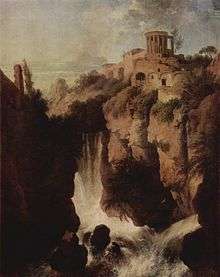
The name of the city came to be used in diminutive form as Tiburi instead of Tibur and so transformed through Tibori to Tiboli and finally to Tivoli. But its inhabitants are still called Tiburtini and not Tivolesi.
In 547, in the course of the Gothic War, the city was fortified by the Byzantine general Belisarius, but was later destroyed by Totila's army. After the end of the war it became a Byzantine duchy, later absorbed into the Patrimony of St. Peter. After Italy was conquered by Charlemagne, Tivoli was under the authority of a count, representing the emperor.
Roman gentes with origins in Tibur
- Coponia (gens)
- Cossinia (gens)
- Rabiria (gens)
- Rubellia (gens)
Middle Ages
From the 10th century onwards, Tivoli, as an independent commune governed by its elected consuls, was the fiercest rival of Rome in the struggle for the control over the impoverished central Lazio. Emperor Otto III conquered it in 1001, and Tivoli fell under the papal control. Tivoli however managed to keep a level of independence until the 15th century: symbols of the city's strength were the Palace of Arengo, the Torre del Comune and the church of St. Michael, all built in this period, as well as the new line of walls (authorized in 1155), needed to house the increasing population. Reminders of the internal turbulence of communal life are the tower houses that may be seen in Vicolo dei Ferri, Via di Postera, Via del Seminario and Via del Colle.
In the 13th century Rome imposed a tribute on the city, and gave itself the right to appoint a count to govern it in conjunction with the local consuls. In the 14th century Tivoli sided with the Guelphs and strongly supported Urban VI against Antipope Clement VII. King Ladislaus of Naples was twice repulsed from the city, as was the famous condottiero Braccio da Montone.
In the city there was also a Jewish community.[4][5]

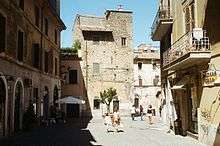
Renaissance
During the Renaissance, popes and cardinals did not limit their embellishment program to Rome; they also erected buildings in Tivoli. In 1461 Pope Pius II built the massive Rocca Pia to control the always restive population, and as a symbol of the permanence of papal temporal power here.
From the 16th century the city saw further construction of villas. The most famous of these is the Villa d'Este, a World Heritage Site, whose construction was started in 1550 by Pirro Ligorio for Cardinal Ippolito II d'Este and which was richly decorated with an ambitious program of frescoes by famous painters of late Roman Mannerism, such Girolamo Muziano, Livio Agresti (a member of the "Forlì painting school") or Federico Zuccari. In 1527 Tivoli was sacked by bands of the supporters of the emperor and the Colonna, important archives being destroyed during the attack. In 1547 it was again occupied, by the Duke of Alba in a war against Paul IV, and in 1744 by the Austrians.
In 1835 Pope Gregory XVI added the Villa Gregoriana, a villa complex pivoting around the Aniene's falls. The "Great Waterfall" was created through a tunnel in the Monte Catillo, to give an outlet to the waters of the Aniene sufficient to preserve the city from inundations like the devastating flood of 1826.
Geography
Climate
Tivoli has a Mediterranean climate with warm and dry summers and cool and wet winters.
| Climate data for Tivoli | |||||||||||||
|---|---|---|---|---|---|---|---|---|---|---|---|---|---|
| Month | Jan | Feb | Mar | Apr | May | Jun | Jul | Aug | Sep | Oct | Nov | Dec | Year |
| Average high °C (°F) | 12.3 (54.1) |
13.8 (56.8) |
16.0 (60.8) |
19.1 (66.4) |
23.6 (74.5) |
27.8 (82.0) |
31.6 (88.9) |
31.3 (88.3) |
27.6 (81.7) |
22.5 (72.5) |
16.9 (62.4) |
13.3 (55.9) |
21.3 (70.4) |
| Average low °C (°F) | 1.9 (35.4) |
2.9 (37.2) |
4.5 (40.1) |
7.0 (44.6) |
10.4 (50.7) |
14.0 (57.2) |
16.4 (61.5) |
16.6 (61.9) |
14.1 (57.4) |
10.2 (50.4) |
6.2 (43.2) |
3.2 (37.8) |
8.9 (48.1) |
| Average precipitation mm (inches) | 74 (2.9) |
74 (2.9) |
61 (2.4) |
66 (2.6) |
56 (2.2) |
43 (1.7) |
28 (1.1) |
46 (1.8) |
71 (2.8) |
89 (3.5) |
100 (4.1) |
86 (3.4) |
800 (31.4) |
| Source: [7] | |||||||||||||
Main sights
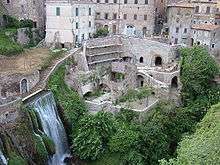
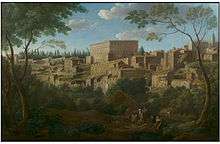
- Villa Adriana, part of the UNESCO World Heritage site list from 1999
- Villa d'Este, part of the UNESCO World Heritage site list since 2001
- Villa Gregoriana
- Rocca Pia, a 15th-century fortress built in 1461 under Pope Pius II to counter the urban strifes between the Colonna and Orsini
- Temple of Vesta
- Temple of "Tiburtine Sibyl" (true dedication unknown). It was built in the 2nd century BC on an artificial platform in the acropolis. Characterized by Ionic columns (only two of which remain today), it measures 15.90 by 9.15 metres (52.2 by 30.0 ft). The interior was decorated by frescoes and stuccoes, now lost. A church, dedicated to St. George, is known to have existed in the temple from as early as 978 AD.
- Sanctuary of Hercules Victor (2nd century BC). Now in ruins, it was one of the largest structures in central Italy at the time, and was located outside the ancient city, across the road leading to Samnium. Measuring 188 by 140 metres (617 by 459 ft), it included a theater, a large porticoed square and the temple. It was reached through a series of terraces, in a similar fashion to the Sanctuary of Fortuna Primigenia in Palestrina. The sanctuary also housed one of the more frequented council of musicians in Roman Italy.
- Tivoli Cathedral (Duomo, rebuilt in 1635–41)
- Roman Temple of the Tosse, located near the Temple of Hercules and the Villa d'Este and dating perhaps to the early 4th century CE. It is a circular structure with a hole in the 12-metre (39 ft) diameter dome. In the 10th century CE it was turned into a church dedicated to the Virgin Mary.
Economy and infrastructure
Tivoli's quarries produce travertine, a particular white calcium-carbonate rock used in building most Roman monuments. The water power of the falls supplies some of the electricity that lights Rome. The slopes of the neighbouring hills are covered with olives, vineyards and gardens; the most important local industry is the manufacture of paper.
Influences
Tivoli's reputation as a stylish resort and the fame of the gardens of the Villa d'Este have inspired the naming of other sites after Tivoli: for example, the Jardin de Tivoli, Paris (France) and the Tivoli Gardens amusement park in Copenhagen (Denmark). The Wörlitz Synagogue in the Dessau-Wörlitz Garden Realm (Germany) is a replica of the Temple of Vesta at Tivoli.[8]
References
- "Superficie di Comuni Province e Regioni italiane al 9 ottobre 2011". Istat. Retrieved 16 March 2019.
- "Popolazione Residente al 1° Gennaio 2018". Istat. Retrieved 16 March 2019.
- Chase, George Davis (1897). "The Origin of Roman Praenomina". Harvard Studies in Classical Philology. VIII.
- Lazio Itinerari ebraici. I luoghi, la storia, l'arte. Editore Marsilio, 1997. ISBN 883176795X.
- Sebastiani, Filippo Alessandro (1828). Viaggio a Tivoli antichissima città latino-sabina fatto nel 1825 (PDF). Foligno. p. 108.
- Seventieth anniversary of the bombing of Tivoli. In Italian.
- "Tivoli historic weather averages in Italy". Intellicast. Retrieved 26 March 2009.
- Wischnitzer, Rachel (1964). Architecture of the European Synagogue. Philadelphia: Jewish Publication Society of America. pp. 158–9.
External links
| Wikimedia Commons has media related to Tivoli. |
![]()